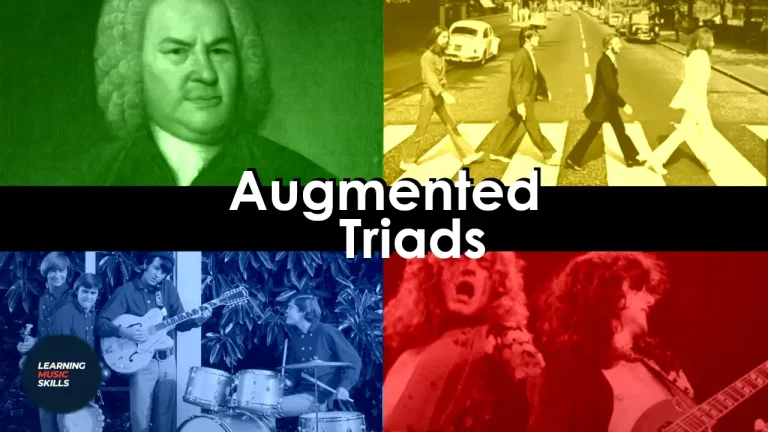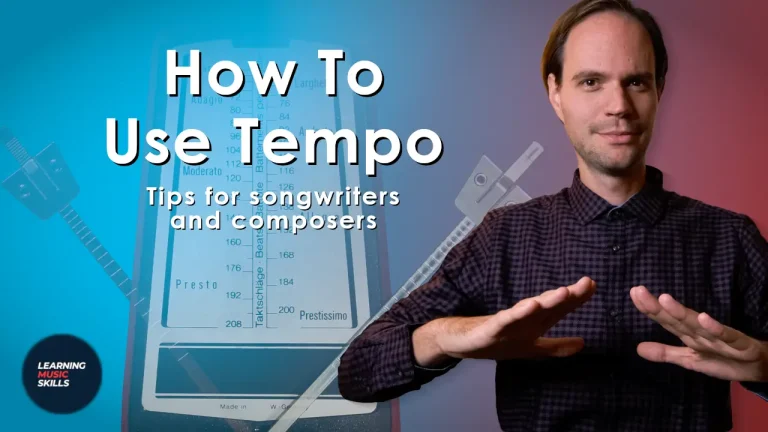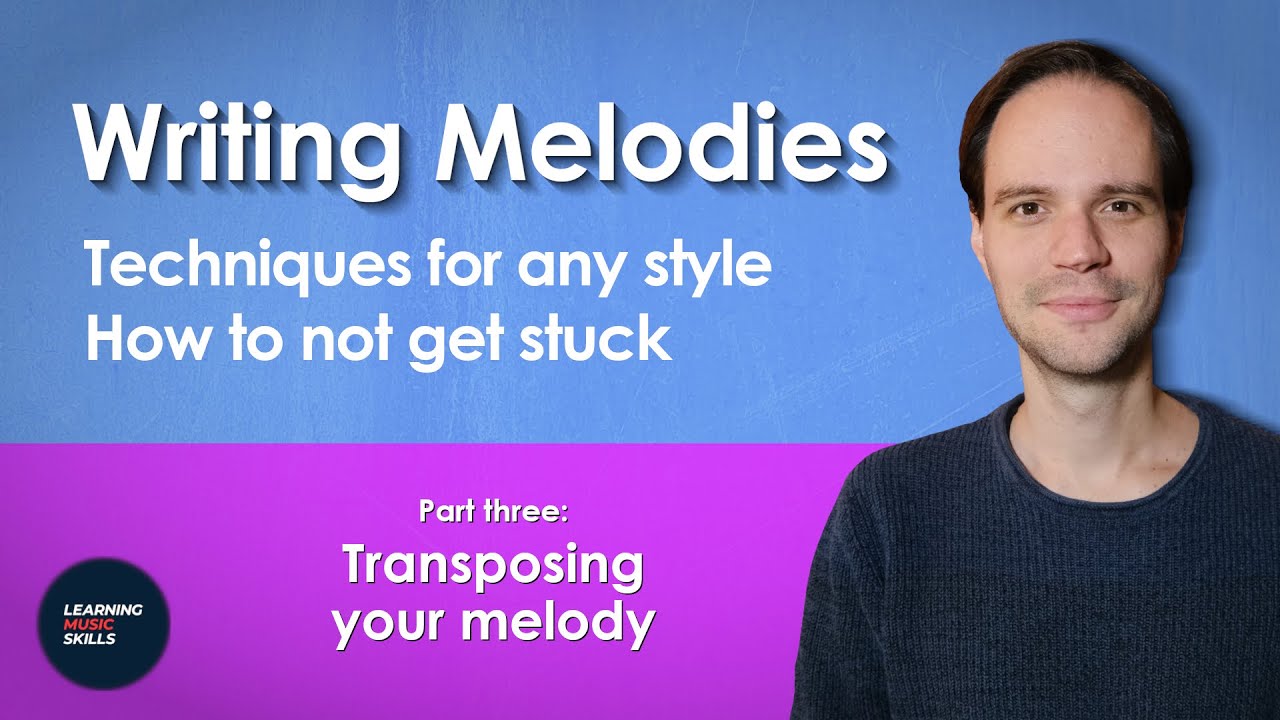Augmented triads are amazing chords! When you follow this guide, you will know what they are and how to build them. Also, I will show you how Bach, The Beatles, John Lennon, Led Zeppelin and The Monkees used them. Let’s learn how to write

This
- What is an augmented triad and how to make them
- Augmented triads on guitar and piano
- Augmented triad chord progressions: Songwriting and composing tips
Augmented Triads Video Tutorial
I made a complete video tutorial about this topic. So check it out if you want something more interactive. You can listen to all the examples from this lesson with real guitar and piano
What Are Augmented Chords and How To Make Them
The augmented triad is a special chord. It has a unique sound and you will recognize it immediately. Because they are so unique this also makes them more difficult to use. Lucky for us, they are easy to make and understand. You create an augmented triad by raising the fifth of a major chord. This raised fifth is called an augmented fifth.
Look at the example below. We start with an F major triad which has the notes F, A, C. To create an F augmented chord you simply raise the fifth tone from C to C#. The interval from F to C# is an augmented fifth.

How to make an augmented triad
Major, minor and augmented chords are all made differently. For example, minor chords are made by stacking a minor third and a major third on top of each other.

Major triads are made by stacking a major third and a minor third on top of each other.

The augmented chords formula is to stack two major thirds on top of each other. The unique thing here is that each chord inversion sounds the same. This is because all the notes are spaced at the same distance. All the intervals are the same. This is especially easy to see on guitar. When you play the different inversions starting on the same string all the chord shapes stay the same.

Augmented Triads On Guitar and Piano
For these chord shape examples, we will use the F augmented chord as a reference. The F augmented chord has the notes F, A, and C# in it.
Augmented chords guitar
On guitar, it is easy to remember the chord shapes for augmented chords. This is because each inversion has the same shape. The augmented triad form does not change. This means that you only need to memorise four different shapes and that’s it! Just look at the charts below.
Augmented triad shapes starting on the 6th (E) string
Here the low E string is our point of orientation. We build each chord upwards from the E string. Then you get the following three augmented triad shapes. Here are the notes of each chord shape. Going from the lowest to the highest chord.
- F+/A = A, C#, F
- F+/C# = C#, F, A
- F+ = F, A, C#



Augmented triad shapes starting on the 5th (A) string
Here the A string is our point of orientation. We build each chord upwards from the A string. Here are the notes of each chord shape. Going from the lowest to the highest chord.
- F+/C# = C#, F, A
- F+ = F, A, C#
- F+/A = A, C#, F



Augmented triad shapes starting on the 4th (D) string
Here the D string is our point of orientation. We build each chord upwards from the D string. Here are the notes of each chord shape. Going from the lowest to the highest chord.
- F+ = F, A, C#
- F+/A = A, C#, F
- F+/C# = C#, F, A



Augmented triad shapes starting on the 3rd (G) string
Here the G string is our point of orientation. We build each chord upwards from the G string. Here are the notes of each chord shape. Going from the lowest to the highest chord.
- F+/A = A, C#, F
- F+/C# = C#, F, A
- F+ = F, A, C#



Augmented chords Piano
There are only 4 different augmented chords possible. This is because the augmented chord is made out of two major thirds. That’s why you only have to learn the D+, Eb+, E+ and F+ augmented chords. When we arrive at F# augmented we have the same notes as D+. Only then the D+ is in the first inversion. You would write it as D+/F#. Let’s look at augmented triads piano.
D augmented chords and inversions on piano



Eb augmented chords and inversions on piano



E augmented chords and inversions on piano



F augmented chords and inversions on piano



Augmented Triad Chord Progressions: Songwriting and Composing Techniques
Augmented chords sound dissonant. They are unstable and want to resolve somewhere. They are chords that create forward motion. People often call them passing chords. A connecting chord in between two other chords.

Led Zeppelin – Kashmir: An augmented triad as a passing chord
The chord progression from Kashmir by Led Zeppelin features an augmented chord that is part of an amazing climbing pattern. This kind of linear motion is also called a line cliche. We will see this again in our The Beatles – Something chord progression example.
The first chord progression is the line that Jimmy Page plays. As you can see and hear, he does not play the major third. But Robert Plant does sing the major third. So when we add this major third to our chord progression we get the 2nd example.

The Monkees – Tapioca Tundra: Two popular ways to resolve an augmented chord
The augmented chord often wants to resolve to the chord a minor third below, or a perfect fifth below. In the verse of Tapioca Tundra by The Monkees we have a perfect example where the raised fifth resolves to the root note of our next chord. Which is the F# a minor third below.

We can also make the augmented triad resolve to the chord a perfect fifth below. Now the raised fifth resolves to the major third of our next chord. Which is the F# from the D major.

Both these examples were in A major. This means that we went from the root or tonic chord to the relative minor. And from the tonic to the sub dominant.

John Lennon – Starting Over: Augmented triads on a static chord vamp
One of the easiest ways to use augmented triads is to play it on a chord vamp. This means that you play one major chord and from time to time only raise the fifth. Which creates an augmented chord.
In the song Starting Over by John Lennon, we can see that he does something similar. When he sings the lines starting over, he plays the A major chord. And then he raises the E to get an A augmented chord. Normally you would expect this A augmented chord to resolve. But instead, he goes back to the A major chord and repeats the same thing.

John Lennon only repeats this chord sequence once. But you can play this for much longer. For example, it could last an entire verse! When you do this you create tension without moving the chord. This creates a strange sense of going somewhere while you are staying on the same chord.

Resolving the augmented chord a full step above
In the beginning, John Lennon classically resolves the A augmented chord. He resolves it to the relative minor chord. Just like we saw in the example from The Monkees – Tapioca Tundra.
But later he resolves the augmented chord to the minor chord a full step above.

If you want to add extra colour you can turn this minor chord into a minor seven chord. This makes the resolution sound very sweet and soft. I recommend you try it out!

Add extra tension to a dominant chord by raising the fifth (augmented fifth)
Augmented chords are and sound like dominant chords. Just like augmented chords, dominant chords are chords that want to go somewhere. They want to resolve. And you can make any major chord sound like a dominant chord by raising the fifth. This will turn it into an augmented chord.
At the end of the bridge section in Tapioca Tundra by The Monkees we have exactly this. Here they start with a regular dominant chord E major. Then they raise the fifth, which turns it into an E augmented chord. And finally, they resolve it to the A major chord a perfect fifth below.
This is a perfect example of how an augmented triad can extend the duration and intensity of your dominant chord.

The Beatles – Something: Turning a minor chord into an augmented chord
Look at the score from the refrain section of Something by The Beatles. Here we have this wonderful downward figure. This is called a downward line cliché. Notice that by lowering the root note with half a step you get an augmented chord.

Of course, you don’t have to play the full downward figure. Like the chord vamp example, you can also switch back and forth. Lowering the bass note half a step, and then back up again. I recommend you try it out. It has so many creative possibilities.

J.S Bach: Starting a piece with an augmented chord
In older times it was required to properly prepare a strong dissonant chord like an augmented chord. And so far the techniques that I have shown you carefully approach the augmented triad. In most cases, this is what you want to go for. To add some subtle dissonance or to add some extra flavour.
But sometimes you want something more shocking. Something that grabs all the attention. In that case, you can also start your song with an augmented triad. Or use it somewhere where it is in the spotlights. This can be the ending or beginning of a new section. A well-known example is Oh Darling by The Beatles. It starts with an augmented chord. But even JS Bach starts one of his pieces with an Augmented chord. Check it out!

In this last example, I used two important augmented triad techniques. The first phrase ends on a C augmented triad. This highlights the unique character of this chord. Also, it creates beautiful tension at the end of the first phrase. The listener knows that the
In the second phrase, we have an example of how beautifully the C augmented in first inversion resolves to the Dm7 in first inversion. This shows an augmented chord resolving to the minor 7 chord a full step above.


Conclusion and Recap
I think that by now you can agree with me that augmented chords can be fantastic. It’s not without reason that so many composers, songwriters and artists have used them in their
You don’t have to use them in every single chord progression. But it does pay off to try to add one whenever you feel that something is missing. It might just add the extra spice that you were looking for. And also, as you have seen in my previous examples, you can even base an entire verse on an augmented triad.
Here is a short list for you to remember what you’ve learned. I’ve shown you that you can use augmented triads:
- To add tension on a static chord vamp
- To use it as a passing chord or connecting chord
- To get an extra strong dominant sound in your chord
- To use it as a striking sound for beginnings, endings and other important parts






